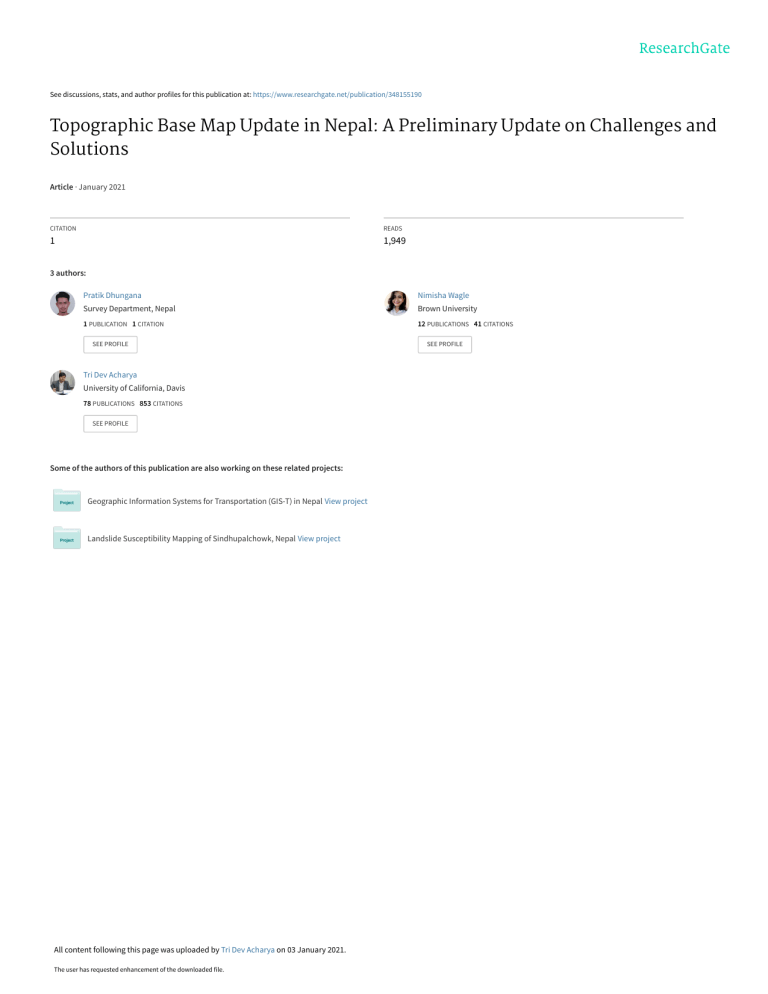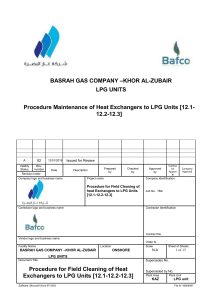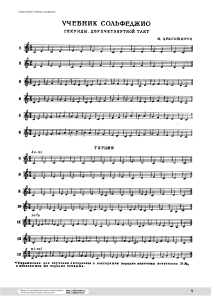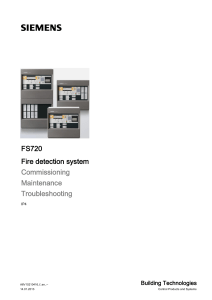
See discussions, stats, and author profiles for this publication at: https://www.researchgate.net/publication/348155190 Topographic Base Map Update in Nepal: A Preliminary Update on Challenges and Solutions Article · January 2021 CITATION READS 1 1,949 3 authors: Pratik Dhungana Nimisha Wagle Survey Department, Nepal Brown University 1 PUBLICATION 1 CITATION 12 PUBLICATIONS 41 CITATIONS SEE PROFILE Tri Dev Acharya University of California, Davis 78 PUBLICATIONS 853 CITATIONS SEE PROFILE Some of the authors of this publication are also working on these related projects: Geographic Information Systems for Transportation (GIS-T) in Nepal View project Landslide Susceptibility Mapping of Sindhupalchowk, Nepal View project All content following this page was uploaded by Tri Dev Acharya on 03 January 2021. The user has requested enhancement of the downloaded file. SEE PROFILE TOPOGRAPHIC BASE MAP UPDATE IN NEPAL: A PRELIMINARY UPDATE ON CHALLENGES AND SOLUTIONS Survey Department, Government of Nepal, Minbhawan, Kathmandu, Nepal 1 School of Geomatics and Urban Spatial Information, Beijing University of Civil Engineering 2 and Architecture, Beijing 102616, China Institute of Transportation Studies, University of California Davis, Davis, CA 95616, USA 3 Pratik Dhungana (1), Nimisha Wagle (1), Tri Dev Acharya (2,3) Email: pratik.tan10@gmail.com; wagle1996@gmail.com; tridevacharya@gmail.com Abstract Topographic Base Maps (TBMs) are essential for any development project as the planning of such a project begins by desk study of the required area using topographic maps. Thus, to help make the best possible plans and decisions, TBMs must show the true and current ground reality. This necessitates periodic updating of these maps. In Nepal, Survey Department (SD) being the only National Mapping Organization has been updating TBMs of Nepal since 2004 and is providing updated digital databases as well. Realizing the demand for updated data, since 2018 SD has been updating more than 200 sheets per year in contrast to around 10 sheets per year in the past. This huge jump in rate is a necessary step to ensure the most up-to-date representation of topographic, natural and manmade features on the base map. However, it has faced many challenges, mainly due to difficult terrain, lack of accessibility, lack of sufficient welltrained manpower, the incompleteness of existing guidelines and specifications and mostly due to lack of proper planning. Learning from experience, many problems have been resolved and some innovations have been introduced to minimize the burden on working manpower and to avoid the introduction of errors at various stages. This paper presents various challenges faced during various stages of the TBM update program along with ways in which they were resolved. It also recommends possible innovative ways to further improve the quality of the output GEOWORLD VOL-IV Key Words Topographic Base Map, Survey Department, Nepal, Challenges, Solutions along with minimizing wastage of human efforts and resources. 1.Introduction Broadly, a Topographic Map (TM) is a 2-D representation of the earth’s 3D landscape, where details of topography, artificial and natural features are accurately represented (Menno-Jan & Ormeling, 2011). A base map is a map showing features of different themes and thus serves as a base to derive various thematic maps (Government of Canada), 2011). A base map is generally produced and maintained by the National Mapping Organization (NMO) of a country. In Nepal, the only NMO of the country is The Survey Department (SD) and TM of scale 1:2500 and 1:50000 prepared from 1991 to 2001 serve as the base map of the country. Topographic Survey and Land Management Division of the department is responsible for the preparation, maintenance, updating & distribution of the Topographic Base Maps (TBMs) of Nepal whereas digital data is disseminated by Geographic Information Infrastructure Division (GIID) (Shrestha, 2009). TBMs of Nepal were prepared at various scales by different agencies. Firstly in 1930, 1 inch to 4- mile scale 26 TBM sheets covering the whole of Nepal 61 were prepared by the Survey of India (SOI). Subsequently, in 1950 by the US Army, in 1970 by SoI and 1977 by the Government of Russia TBM of Nepal were prepared. To address the need for technical manpower and equipment for TBM preparation, the Topographical Survey Unit was established in 1972 under SD, which was then upgraded to Topographical Survey Branch in 1976. But it was not until 1993 when Japan International Cooperation Agency (JICA) aided in preparing 81 map sheets of the Lumbini zone, that Nepal was actively involved in the topographic mapping of the country (Wagle & Acharya, 2020). This marks the beginning of the active involvement of the Government of Nepal (GoN) for TBM preparation. Right after this, Eastern Nepal Topographic mapping (ENTMP) which produced (255 sheets of 1:25000 & 57 sheets of 1:50000 scale) & Western Nepal Topographic Mapping (WNTMP) producing 254 sheets of 1:25000 and 79 sheets of 1:50000 map were carried out with financial aid from Finnish International Development Agency (FINNIDA). These JICA and FINNIDA map series maps were subsequently digitized to produce a Digital Topographic Database which is called NTDB (Shrestha, 2009). and producing updated maps. Initially, the rate of the update was around 10 sheets per year (Wagle & Acharya, 2020). Considering a total of 681 sheets of the combined JICA & FINNIDA, at this rate, it would have taken around 68 years to update TBM of the whole Nepal, which would already have been outdated. Thus, realizing the necessity to increase the speed of updating, the SD since 2018 has been updating more than 200 sheets a year using ZY-3 images provided by the Government of China. This significant increase in target comes with many challenges. During these two years, many challenges have been faced and resolved and some are yet to come. This paper presents the challenges faced during different stages of TBM update and the way they were handled. It also recommends some innovative ways wherever applicable. 2.Current Status Of Topographic Map Updating From 2007 to 2017, in total around 70 map sheets were updated. Since 2018, more than 400 sheets have been updated, half of these map sheets are ready for print validation and the remaining half are currently undergoing cartographic work and will Since 2004, the SD has been updating these databases shortly be ready for field verification. The speed Figure 1: Topographic Map Sheets of Nepal from JICA and FINNIDA series. 62 Geomatics For Sustainable Development of work has increased tremendously, but this has increased difficulty in quality control. Due to the large number of maps being updated, it is not possible to check each map thoroughly. Thus, it is even more important to consider every challenge that can arise at every stage of map-making and prevent them from happening rather than to check thoroughly later and correct them. Making suitable strategies to minimize the introduction of errors at different stages from planning, image processing, georeferencing, feature extraction, field verification, data collection, symbolization, map layouts and printing is necessary for wise utilization of available human resources. A substantial time for fieldwork consisting of GCP collection, feature extraction, field data collection and field data verification followed by even longer duration of data validation and cartographic work was required in the first year to produce updated NTDB and TBM, which was almost twice more than initially planned duration. This, in turn, caused a delay for work of the year that followed, but various challenges faced in the first year were resolved before moving to the field for the second year which helped to some extent to make up for the delay. Section 3 of this paper discusses these challenges, along with the way they were handled. 3.Dividing Into The Challenges This paper is all about the challenges which appeared in every phase of update of TBMs. The methodology followed for updating the TBM is shown in Figure 2. Various challenges were faced by the survey professionals and management committee during this procedure. The challenges in different phases are discussed below. 3.1 Planning Phase As with every project, success & smooth flow of work of TBM updating depends upon the planning. First of all, sites for sheets to be updated are selected and different teams are assigned for different sheets updating. In 2018, sheet division among teams was such that different teams had to visit the same district or even the same local unit for data collection & field verification, which is not a very effective way. Sheet division next year was planned so that any particular team would have to visit certain districts and no two Figure 2: Workflow diagram of Topographic map updating process. GEOWORLD VOL-IV 63 teams would be visiting the same districts. Moreover, in the previous year, teams were deployed for fieldwork before proper planning for control surveying, which resulted in wastage of resources for collecting redundant ground control points. In the following year with proper planning, it was easily avoided, which saved a lot of time and effort. While planning, it is important to study the accessibility, topography and density of details at areas under targeted sheets. With proper consideration, teams can be assigned optimum routes and an equitable amount of work thus avoiding wastage of resources & manpower. For planning existing topographic databases, Images and data from sources like google maps & OSM should be studied. Secondly, it is beneficial to complete the tasks that can be completed in the office itself before moving to the field. In the past just after image selection and their processing, teams were deployed in the field for data collection and verification. Thus, some members were collecting Ground Control Points (GCPs) for georeferencing, while others were collecting field data from local units. As it is harder to distinguish features like canal and road among others just by looking at the image, later on, if data about them is not collected in the field, then there arise chances for blunder. To avoid that, an innovative approach would be to complete feature extraction and digitization before field verification so that any possible mistakes in identifying features can be checked and corrected. It can be ensured by completing all tasks of GCP collection, image processing, georeferencing, digitization and feature extraction before moving to the field for verification and data collection. Thus, a change in methodology is required. to reach at the exact location of features to be collected and capture their location. Fortunately, there are several official institutions which keep records of various features that are to be shown in a topographic map. Compilation of data from these sources before moving to the field and their verification, later on, would decrease the volume of work. Moreover, existing topographic maps along with present satellite images can be used to collect and verify attributes of features easily identifiable in them such as road, buildings etc. Applying this solution has to a great extent helped gather more data, even when the location of those features being collected is not accessible. Moreover, collecting data after a long time requires a lot of manpower and budget. If data is collected frequently by compiling from different authentic institutions, there won’t be much change so can be verified by existing manpower with a minimum of expenses, and can produce a map showing the current state of the real world. Thus, by employing this innovative approach of currency checking at frequent intervals, it would be possible to circumvent large field works demanding huge resources and many people. 3.3 Image Processing and Geo-referencing Phase TBMs are updated by using remotely sensed ZY-3 satellite images. Not all images would be equally desirable for this purpose. Visually pleasing images with minimum haze & cloud cover and preferably of the same row or same path would make best candidates. The extent of images dictates the requirement of control points. If images can be mosaicked or are at least overlapping properly this would reduce the number of GCPs to be collected. Now in the hilly region, collecting even a single GCP can take up to 2 days, it would be beneficial to choose images properly. Finally, the inability to coordinate with concerned local representatives and offices in the field area is also a major challenge. A lack of prior information to them had been a cause of delay in the past year but can be solved by contacting and coordinating with The general process is, suitable selected images are ortho-rectified & then pan-sharpened to obtain them before moving to the field. images with high spatial and spectral information. 3.2 Fieldwork Phase Different pan sharpening techniques produce different Fieldwork is a challenging task due to the difficult results. As of now, it has just been hit and trial. terrain of most of the country and lack of good Proper testing of different techniques with different accessibility. For these reasons, it’s almost impossible images and coming up with recommendations would 64 Geomatics For Sustainable Development be helpful, as pan-sharpening takes quite a bit of time. After pan-sharpened images are obtained, these are to be georeferenced so that existing topo data can be overlayed with them to identify and update the changes. The main problem here lies in the transformation parameters. With GNSS survey, GCP coordinates are obtained in WGS 1984 ellipsoid whereas existing topo data have a coordinate system based on Everest 1830 ellipsoid. The uncertainty of exact parameters for transformation between these two coordinate systems contributes to a large shift in the existing database and image to be overlayed. Using different sets of parameters resulted in a shift of up to 22m. To avoid this shift, transformation parameters for FINNIDA series were tested on multiple images and their shift with the existing database was almost found to be under the permissible region. Thus, using these parameters, WGS 84 and Everest 1830 based coordinate systems can be easily transformed between one another, which has helped to compare with data from different available sources. Besides these, a major challenge that arose in the past, due to lack of coordination between different groups while georeferencing, is difficulty in edge matching. Images were not exactly seamless and there were visible shifts in data of adjoining groups in the margin. In the later year, this challenge was solved by using the same georeferenced images by multiple groups wherever possible. This has led to creating seamless data more easily. Figure 3 Shift in images of two groups at edges. GEOWORLD VOL-IV 3.4 Feature Extraction and Digitization Phase After overlaying an existing database with georeferenced images, updating is done by digitization which is highly labour intensive. Simply digitizing may not require highly skilled manpower, but one without knowledge of different relationships that exists between different data such as contour & streams, road and contour, etc. may not produce correct data. Also, there lies some subtle differences with features from different topography. Prior knowledge of what kinds of features exist in the region and what they look like along with the ability to understand existing databases is essential to ensure the correctness of digitization. First of all, in this stage, major problems arose from wrong estimates of the capacity of manpower due to the inability to correctly recognize the difference between nature and volume of details in the past & present year. For example, Roads in terai are straight and visible so can be easily digitized accurately without zooming much. However, for hilly regions, these have many bends, and one should consider not only accuracy but also a cartographic generalization. Thinking that people gained experience by updating maps in Terai, they were without any further training assigned to update maps of the hilly region. This resulted in digitized roads with sharp bends and overlapping features when printing or at reference scale. Thus, thinking beforehand about possible differences in work, manpower must be trained for such cases, so that repetition of work and wastage of resources can be prevented. Moreover, features are digitized sometimes with incorrect attributes. This incorrect attribute is partially due to inconsistency in feature code representing attributes. A lack of complete symbology and list of feature codes has caused us to create new symbols & define new feature codes as we go, and has sometimes caused conflict. As these codes and symbols are changed many times before finalizing there lies the chance of these codes not -being updated properly in some data. Thus, studying possible features that will be encountered and then defining symbols and feature codes beforehand could mitigate this challenge. As of now, almost all of the features that have been encountered has been 65 given proper feature code and symbology, making an exhaustive list is surely necessary for consistency of work. Compiling data from authentic sources and modifying them would minimize incorrect attributes and even reduce the number of new features to be digitized from scratch. Proper training to avoid topological errors should be given so that time can be saved frequently checking and correcting topological errors. A less labour-intensive approach should be applied wherever possible. For example, the available image can be classified to produce land cover data. Developing a suitable model to produce land cover would save the labour needed for digitization. Secondly, the lack of powerful computers and software is also a big problem. Sometimes programs crash midway while digitizing, causing loss of progress. Identifying and distinguishing features also becomes cumbersome looking on these laptops. Computers become slower with use and hinder the speed of digitization. Moreover, laptops with a small screen are not ideal for digitization. Thus, a simple solution lies in providing powerful desktops with large monitors and genuine software to help digitize faster and more accurately. 3.5 Map compilation This is the stage that has seen most innovation and has had a great amount of reduction in complexity. During map compilation, all data are presented in a predefined layout. Map title sheets no., legends and other marginal information are added. Grids, graticules and their values are added, features are labelled and those labels are placed at appropriate positions. Just a year back, all these tasks were very labour demanding but now they have become much easier. Labels of features can be easily managed as annotations. Grid and graticules, as well as sheet no. and titles, can be automatically generated reducing chances of human error & requirement of human labour. Templates are ready to use and can be changed easily as most of the map elements have been created now as features in a database, thus can be easily added to as many map documents and as many different templates as needed. Thus, finalizing the database is almost finalizing the map. Moreover, symbology for almost all encountered features is also prepared. After map compilation, comes map printing and reproduction, where the challenge was of colour management. However, by using CMYK Figure 4: Some problems in digitization: (a) sharp bends (b) undigitized roads (c) wrongly digitized roads (d) different land cover categories at the edge (e) intertwined road and hydro lines (f) discontinuous road (g) intertwined old trails and new roads 66 Geomatics For Sustainable Development colour charts to pick appropriate colour values for symbols in the map, exporting the map in the same colour system and printing with the same colour system has solved that. Now, these maps, which after all these stages, test-printing & validation can be mass-produced as required using a computer to plate technology in offset printing. 5.Reference • Government of Canada, 2011. National Topographic System. Retrieved January 22, 2020, from https://www.nrcan.gc.ca/earthsciences/geography/topographic-information/ maps/nationaltopographic-systemmaps/9767 • Menno-Jan, K.; Ormeling, F.,1996 Cartography: Visualization of Spatial Data, 1st ed.; Pearson Education Limited: Essex, UK; pp. 205. • Shrestha, K. G., 2009. Updating of topographic maps in Nepal. Geoinformatics Journal of Nepal, vol.VIII, pp. 52–56. • Wagle, N., & Acharya, T. D., 2020. Past and Present Practices of Topographic Base Map Database Update in Nepal. ISPRS International Journal of Geo-Information. 9(6), pp. 397, doi:https://doi.org/10.3390/ ijgi9060397 4.Discussions And Conclusions Used for navigation, planning & implementing development projects, topographic maps need to be up-to-date to reflect the correct state of the real world and help make appropriate plans. Realizing this, the SD has prioritized this task, and the TBM update has gained huge speed these past two years. However, several challenges lie ahead. Maps in the Terai region have been updated, and now these in hilly and mountainous regions are to be updated. These areas present more challenges in terms of terrain, accessibility, ability to coordinate with concerned local offices and the sheer amount of digital work to be done. Mapping these regions may require new methodology, symbologies, map layout and training of manpower. Many challenges are being resolved as we’re learning from experience, but that seems not to be enough. So, learning by studying what we may encounter has also been equally important. Proper planning, coordination with concerned authorities, training manpower, proper assignment of areas to teams, making available required machines and software, employing automatic feature extraction, compilation of data from available sources would help in reducing the difficulty of tasks and solve most of the challenges. Checking the currency of maps at frequent intervals will help to produce high quality up-to-date topographic maps with minimum human labour and expense of resources in the future. A developing country like ours should make a go for these. GEOWORLD VOL-IV View publication stats 67




